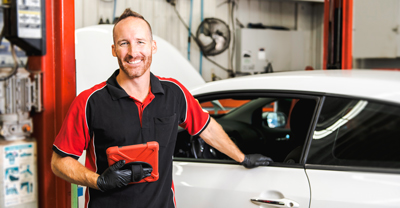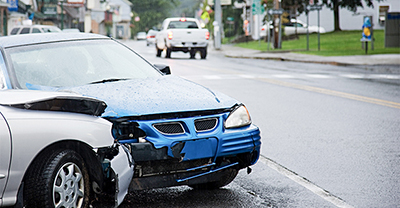Finding a trusted auto repair shop after an accident


0 min. read
Getting into a car accident can leave you shaken. Your first concern is safety—but once the dust settles, you’re often left wondering: What happens to my car? Who can I trust to fix it?
While every accident is different, one thing is true for most drivers: Choosing the right repair shop can help make a stressful situation easier. This guide provides practical steps to help you choose a reliable and respected auto repair shop. Explore Dairyland’s cheap car insurance options to find the coverage that fits your lifestyle and budget.

Get started with a free auto insurance quote.
Contact your insurance provider first
Before getting any repair estimates, start by filing a claim with your insurance company—or the at-fault driver’s insurer, depending on the situation. Be ready to share:
The date, time, and location of the accident
A brief description of what happened
Information about the other driver(s) involved
Your policy’s coverage may determine which costs your insurance can help pay for. If you’re at fault in an accident, or if the other driver doesn’t have insurance, your collision coverage could apply—depending on your policy and state requirements. In most cases, you’ll pay a deductible before your insurance may cover the rest.
Your insurer may recommend a repair shop from their preferred network. These shops can work directly with the insurance company on estimates and repairs. However, you're not required to use a repair shop recommended by your insurer. You have the right to choose where your car is repaired.
Ask people you trust for recommendations
Word of mouth can go a long way. Ask friends, family members, or coworkers about their experiences with local repair shops—both good and bad.
And don’t stop at “they did a good job.” Ask why they recommend the shop. Was it for fair pricing? Quick turnaround? Clear communication? Also, ask if they’ve had poor experiences you should avoid.
Focus on recommendations for a shop that specializes in post-accident repairs—not just routine maintenance like oil changes or tire rotations.
Read online reviews and testimonials
Reviews on platforms like Google, Yelp, Angi (formerly Angie’s List), and the Better Business Bureau can offer valuable insight into how a shop treats its customers.
Check for comments about:
Customer service
Turnaround time
Pricing transparency
Quality of the repair work
If you come across a negative review, take a look at how the shop responded. A respectful, solution-oriented reply can be a good sign of professionalism.
Choose the right auto repair shop
Once you’ve narrowed your list, connect with a few shops to get quotes—and a sense for their service. If your vehicle isn’t drivable, you can still do this by calling ahead, reviewing their website, or having your vehicle towed there for an estimate.
Things to pay attention to—whether in person or virtually:
Cleanliness and organization (photos or a quick walk-through if possible)
Friendly, knowledgeable staff
Willingness to explain the repair process
Transparent, detailed estimates
Helpful questions to ask:
What kind of repairs does my vehicle need?
Do you have experience with my car’s make and model?
How long will the repairs take?
Do you provide a written estimate?
Are your mechanics certified?
Is your shop independently owned or part of a national chain?

Review your coverages with a free auto insurance quote.
Look for certifications and licenses
A reputable repair shop typically has industry-recognized credentials like:
ASE certification: Mechanics certified by the National Institute for Automotive Service Excellence (ASE) have passed industry-standard testing and renew their certification regularly.
Manufacturer certifications: Some shops are certified by specific car brands (like Toyota®, Ford®, or Audi®), meaning their technicians have training and access to parts that meet the manufacturer’s standards.
State licenses: In some states, repair shops must be licensed. You can look up shops through your state’s licensing board.
Ask about repair warranties
Quality repair shops stand behind their work. Ask what type of warranty they offer—and get the details. This protection can provide peace of mind long after the repairs are complete.
Key questions to ask include:
Does the warranty cover both parts and labor?
How long does it last?
Is it valid at other locations if the shop is part of a chain?
Get a written repair estimate
Don’t hesitate to get more than one estimate. This isn’t just about comparing prices—it’s also about understanding each shop’s repair approach. A detailed, written estimate can help you better understand the work involved and feel more informed about your decision.
A good estimate should include details such as:
Labor time—the estimated hours needed to complete the repairs.
Cost and type of replacement parts—these may be original equipment manufacturer (OEM) parts made by your vehicle’s brand, or aftermarket parts made by other companies.
Paint and materials needed—including the type of paint and any special coatings.
Any teardown or inspection procedures—work needed to assess hidden damage before repairs begin.
Share the estimate with your insurance company
Once you've chosen a shop and received an estimate, send it to your insurer for review before work begins.
If the insurance company agrees to the cost:
You can authorize the repair
You pay your deductible to the shop
In many cases, your insurer communicates with and remits payments directly to the shop
If your insurer doesn’t approve the estimate as submitted, they may suggest adjustments, request additional information, or recommend another shop. In that case, you can review their feedback with your repair shop to decide on next steps.
If you have questions at any point, speak with your repair shop—they can help guide you and may even work directly with the insurer on your behalf.
Your insurance safety net after an accident
Having proper coverage can help ease the stress after an accident. Dairyland®, a brand of the Sentry Insurance Group, offers cheap car insurance options—including collision, liability, and comprehensive coverages. Add-ons like roadside assistance or rental reimbursement can help provide extra support during the repair process. Contact Dairyland today to learn more.

Get your free auto insurance quote today.
*All product names, logos, brands, and trademarks are property of their respective owners. All company, product, and service names are for identification purposes only. Use of any of the foregoing does not imply endorsement.
The general information in this blog is for informational or entertainment purposes only. View our blog disclaimer.










